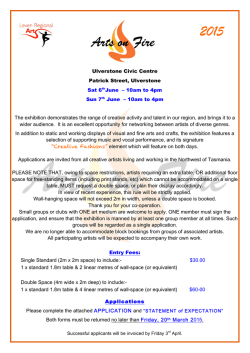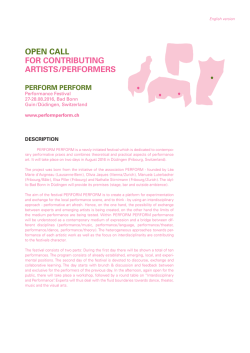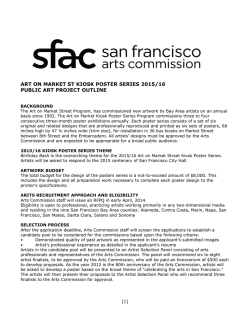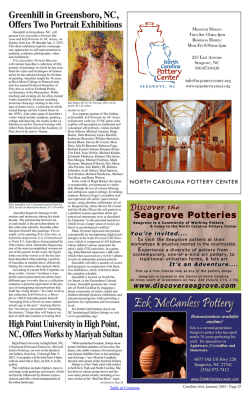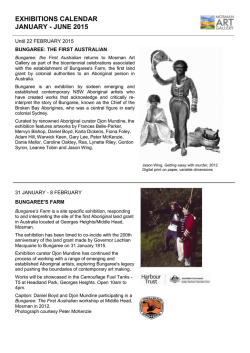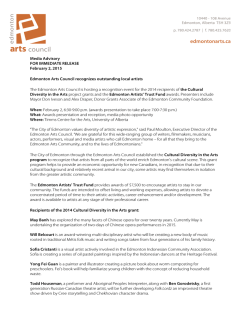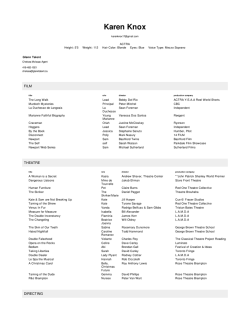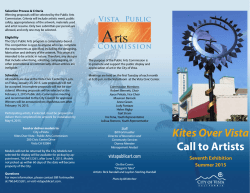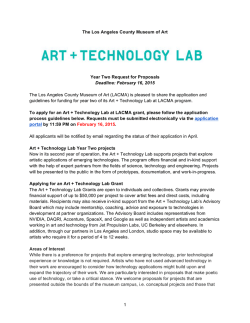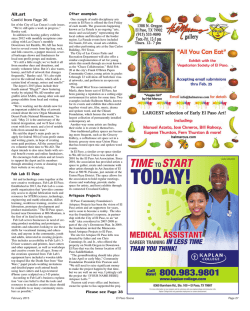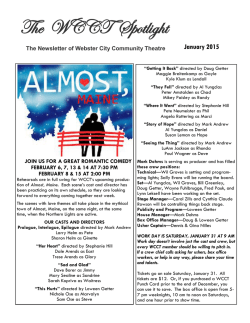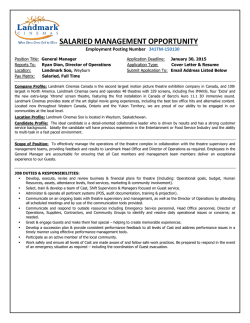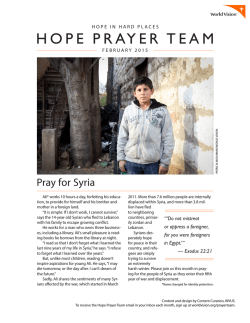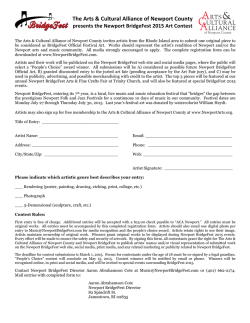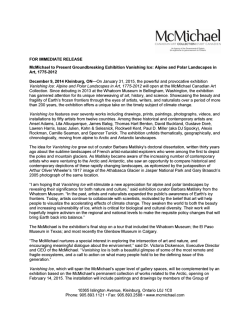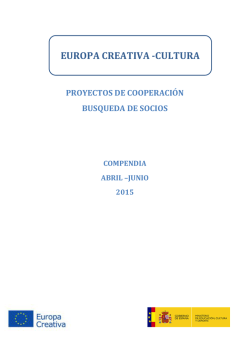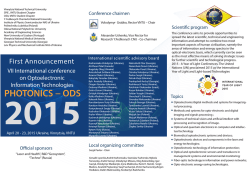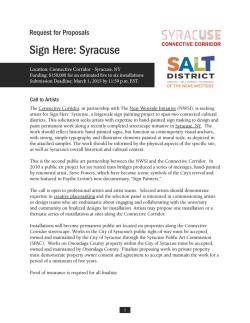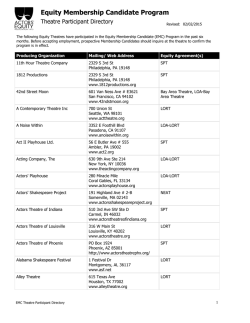
Record of discussion on day one of Culture and
Culture & Conflict Summit Day 1 Pre-Conflict The cycle of conflict, humanizing the enemy, creative expression under repressive regimes Case Study 1– Andrea Rose, British Council Case Study 2– Shahid Nadeem, Ajoka Theatre Commentators– Michael Shank, Friends Committee on National Legislation and John Paul Lederach, author of The Moral Imagination Moderator – Maria Stephan, US Institute of Peace Questions from the delegates: 1) How do we measure impact? a. It’s convenient for governments to say ‘we can’t do M&E in the arts’ because they’re doing immeasurable things in other ways. The Pentagon, USAID and DoS, if they wanted to pursue M&E, they could. DoS has used hip-hop and music to win hearts and minds on the ground in Iraq. The government can move monies quickly, but if it’s something that Congress has to sign off on, then it’s even more difficult. For a while, it’s going to be discretionary money that’s spent because it’s argued you can’t spend M&E on arts. But we have seen measurable impact in Pakistan – women’s involvement in the public sphere increases because of their participation in theatre. In parts other than the north, this is how women are entering the space – through theatre. b. It’s not quantifiable – art and culture – but the best way of measuring impact is by being there. It is difficult to put reactions to art into a report. You also need to look at how individuals are impacted. Lives can be changed. None of this is quantifiable, but it is significant. c. People need champions to argue the case on Capitol Hill for art and safe places. d. Think more about our theories of change – how do things change in places of conflict? Not just looking at quantifiable and qualitative evidence, but looking at approach and thinking – the theoretical. Our project mentality has overtaken us. We have to think in relative terms in the changes that are underway in a place – like Colombia. e. Our timeframe is inadequate to address the things we’re talking about. We have to accept that there will be setbacks. f. Much has changed due to digital technology and we need to use it. g. In Pakistan, normal dialogue cannot address political issues and political restrictions, but theatre, music and art can. 2) How does the idea of contact through cultural exchange shift to building relationships? Once relationships have been formed, how do you sustain them? a. Relationship building takes time. We (British Council) set down roots –in Russia, the roots are there – temporarily truncated, but the root is there. Liberal Russians want change, and we have the capability to communicate things like plurality and diversity because of technology and digital communications. 3) What is surprising about North Korea? a. It is a society and they are as normal as their counterparts in South Korea. But there is no opportunity for an alternative voice. b. For North Koreans, there is no individual. All art is produced in a factory to prescribed formulas. British Council is bringing to the UK two groups of North Korean artists in September. The idea is begin to acclimatize these artists— showing them what art can be. China has taken 30 years to get savvy about the art market. It is a good example of what can happen over time. Over time, experience and knowledge translates into a form of wisdom. What we are trying to impart is a more generous sense of what the world can be. If we can communicate to individuals that they can express themselves through art, we can plug them into what the rest of the world is plugged into 4) How do we acknowledge the paradox between instrumentalization, measuring impact and evaluation and building relationships? 5) Having arts at the center instead of the periphery, how do we disseminate stories of success in the area of the arts and measure impact in this area? How do we hear and elicit the stories of success? 6) How does the idea of contact through cultural exchange shift to the building of relationships? What are the signs or indicators that this change has taken place? Once those relationships have formed, how do you follow up with what’s been created? Mid-Conflict Challenges and opportunities for culture amidst violence Case Study 3– Malu Halasa, Syria Speaks Case Study 4– Olena Chervonik, Izolyatsia Commentators –Principal Deputy Coordinator Jean Manes, International Information Programs, U.S. State Department and Sandra Melone, Search For Common Ground Moderator– Melanie Greenberg, Alliance for Peacebuilding Presentation points: Art is a victim during conflict. If you want to help the Syrian people, you need to get their voices heard. There is an overwhelming sense of loss in both Ukraine and Syria. These artists are addressing legacy and how to create a lasting culture through art expression and bring in art leaders to help with this process (in Ukraine). The 1982 massacre in Syria also has a lasting legacy. In conflict zones, people are restricted from freedom of expression – part of our role is to make people feel connected and to connect people, help people to not feel alone. There are constant conflicts – there is the issue of measuring the impact of having people sharing their stories while not putting them at no unnecessary risk or other risks media-wise. o In Afghanistan, you wanted to show women ‘making it’ and how they could impact other women without turning it into a US-centric media storm that doesn’t get to the true point. How do you work with partners in order to go to the next level – identify partners with a core concept and get them training (Afghanistan). This makes sure women aren’t being set up to fail but have a foundation for moving forward. This also helps them to scale up or duplicate efforts. Try to lead with policy then spending time listening to host country or partner – find common ground to move on. Sometimes it’s just the wrong timing for an initiative. It’s hard to get things done if a host partner or community or country doesn’t want to do something. Therefore, it’s best to listen to what they want – let the community lead. Unilateral initiatives do not last long. Find passionate and good-faith partners. That’s where success comes from. Identify the right people; get them the right training and access and resources. Government can then be more effective in its initiatives. It isn’t easy to use arts and culture to change the way people engage with each other. There is no doubt that the traditional forms of bringing people together are effective mechanisms as ways to do conflict transformation. Engagement sometimes needs to be below the radar screens – sometimes some conflicts are too dangerous. SFCG – participatory theatre – helps people to act out conflict and find the differences and common experiences Questions from the delegates: 1. Is autonomy important for artist practitioners working in conflict? o A lot of academic research on the Middle East has an agenda. Freedom comes from talking to individuals and citizens who feel they don’t have a voice and giving them one. 2. For Ukraine – how do you see the future? What can we do? For Syria – How are you succeeding in getting these voices to the policy level (citizens and artists)? o The future of Izoylatsia – they won’t go back; they have relocated to Kiev. There is no academic research about the politics, culture or economy about the region and they want this research done. They are reaching out to universities like NYU to start a joint program. They have also reached out to the local Ukrainian academic community and are trying to raise money to get more production studios. 3. How do you take stories and share them with a wider audience to inspire others in the Middle East affected by the Arab Spring (besides social media)? o In zones of conflict – the word ‘dialogue’ – is actually a controversial word. Thus, words and definitions are important for reaching some audiences in some conflicts. o Use networks like USIP, Alliance for Peace Building. Post Conflict De-escalating violence, conflict management, transformation, and resilience Case Study 5- Cynthia Schneider, Georgetown University Case Study 6- Michael and Jacqueline Lessac, Global Arts Corps Case Study 7- Leon Shahabian, Layalina Productions Commentator – James Thompson, University of Manchester Moderator- George Lopez, US Institute of Peace Presentation points: Culture is the source of the Malian economy The extremists understand how important culture is; the ‘good guys’ need to understand this as well in Mali Building culture will bring tourists and investments; it will get attention to other challenges that Mali faces (desertification, climate change) Is it a mistake to work with only binary unions? Eg. Using Roma for an initiative with Serbs and Bosnians. Are we better off creating a production that covers more than one conflict? Should we instead use three or four conflicts to create one degree of separation between the artists and the audience? If done, there would be interaction between 4-5 cultures and artists. Each one will have the chance to poke holes in each other’s entitlement or victimhood. Lebanon – history isn’t taught pre-independence. Each community has its own experience. o Some communities believe they have something to gain from another war (Syria). o There is a way to measure targeted audiences – to measure change. M&E can be quantified, but it costs money; 20-25% of the project budget to do it right. The idea that you can’t do art work until other issues are sorted is untrue. Some places have extreme destruction, but art can still thrive there. Remember ancient history – Greek theater – to work out how the Greeks dealt with war, what they did on the stage. Art can be about making war (Picasso aimed for this) – is it about art challenging us? Instantaneous art as relief; art is the bunker. It is the metaphorical bomb shelter to protect people in extreme situations very quickly. A lot of work with children serves as instant relief. Art can project provocations – there’s a lot of work about consolation as well. In contemporary war zones, the word consolation is used often. A lot of projects look to humor and entertainment to distract people from the situation rather than confronting it. This notion can obviously be disputed. Art unveils. Art can deliberately keep things private and silent and concealed. Art, we assume, is a public form. But in fact there are a lot of projects that will quiet and engage a room. Policymakers should consider work which may not be seen or put in a brochure. Private work can sustain a community that may not be able to go public due to dangers. Art as tools – we can’t have it both ways. If we don’t like instrumentalization, we can’t continue to use art as a tool. Art does ‘do’ things, and it does things with people. But we need to think about the opposite of that idea. Artists need to also think about the affect of art (not just the effect). Humanitarianism is a form of theatre – it is about showing results to communities, interacting with an audience. It is a form of show and tell. It is a performed project. Artists can get into the gaps of humanitarianism and find the faults and issues. Envisioning sessions: Actionable next steps and recommendations: Table 1 Advocate for opening up people’s perceptions of how culture and conflict are interrelated. o o o o o Not having rigid definition of a human rights defender. We should protect them more when they are leading conversations in their societies. Advocate for them. It is important for government money to be put towards infrastructure of art and not just the content. Having freedom of expression is revolutionary. Work more closely together across sectors to benefit from knowledge and experience Mentality change: advocate or introduce more broadly the idea of art as a key to addressing conflict. Being able to explain this role is important in and of itself. Do not be limited by categories. The arts and culture is limited and sometimes not relevant to conflict and human rights. Make sure we don’t have unnecessary borders as to how art can be applied to conflict. Table 2 If the arts are core and not periphery, the discussion is closed and closed to a certain group. We should have people from different parts of the US and those people should be charged to bring their elected official with them. We need to open up the conversation and advocate better. International collaboration: where are the opportunities for thought leaders in different countries that may want to address a certain part of the world to address the conflict better? City and local level in the US has some important examples of interaction of art, conflict, society and economy. How can we use these examples to compare internationally? There needs to be political independence of cultural engagement for organizations We should be on the lookout for when political conferences are focusing on a certain region. It would be interesting to aggregate the experiences of different organizations to feed into these conferences to show how art feeds into that certain region. Art can sometimes feed misconceptions or misinformation (Braveheart and Scottish history) Table 3 Partnership (foundation of relatedness and trust are the themes for these recommendations) o Feedback loop is messy. Partnering is messy. We should look at a feedback loop where there is testimony from people on the ground to be informative in the entire process. Look at ways that partnership is prescriptive rather than rigid. It should be less about perceptions of the dominant and submissive. Create a more circular environment. Look at the natural cycle. o Channels of communications and organizational culture: there is some sort of theory of change in arts programming. Communicating stories – the experiential aspect of art – gets taken out in communication and in M&E. o In organizational cultures, how do we bring art into an organization’s own process? o How we communicate: we all have donors. We have to speak the language of donors to get practical funding and support Table 4 How to influence policymakers and funders o o o o o How do we fund ‘the study’ that produces numbers and statistics which shows that this is worthwhile work? Can we use a strategic assessment tool or military tool and adapt it to a cultural assessment piece? Define field, method, functions – do a literature review to define all the work that happens in this field. Find one voice. Find a way to fight for arts and culture and why it matters Understand our foreign policy is out of options. How is our theory of change working so far? We’re funding cuts across the board for arts. Fund a study to connect the different sectors in the field Table 5 How can we work with assessment that meets the needs of the field and not just the investors or funders? This lack of assessment steals needed energy. o We need structures that deepen dialogue, generate knowledge, and address ethical questions. o Be driven by a sense of excellent work that draws on knowledge bases of artists and others in the field o We need creation of long-term authoritative structures Table 6 More academic research is needed Incorporate art work in all projects and funding Stop using project mentality and use long-term view Reframe theories of change Scale up impact and go beyond personal experience and move on to national level Build community support for artists as well as general community o Create physical space for platforms and sharing How do we deal with spoilers? How do we reach them? Should we reach them? (People who destroy artifacts and monuments and artwork) Table 7 Create a LinkedIn group or webpage to keep everyone in this room together. A one-off report will not create longevity. Need a professional organization that will gather this group regularly Scale up our work and advocacy to donors and go as a united front Create safe houses for artists Table 8 An academic conference to catalyze more research is needed A Think Tank report needed – CFR or Brookings, somebody powerful Build network and consortium to go for best practices and funding sources Draw on the experience of UN Resolution 1325 – get all arms of the UN to integrate culture into their work. Call for national action plans to elevate culture and peacemaking. Elevating issues in ECA – make Culture and Conflict one of the themes Global education agenda needs to bring these issues in
© Copyright 2025
